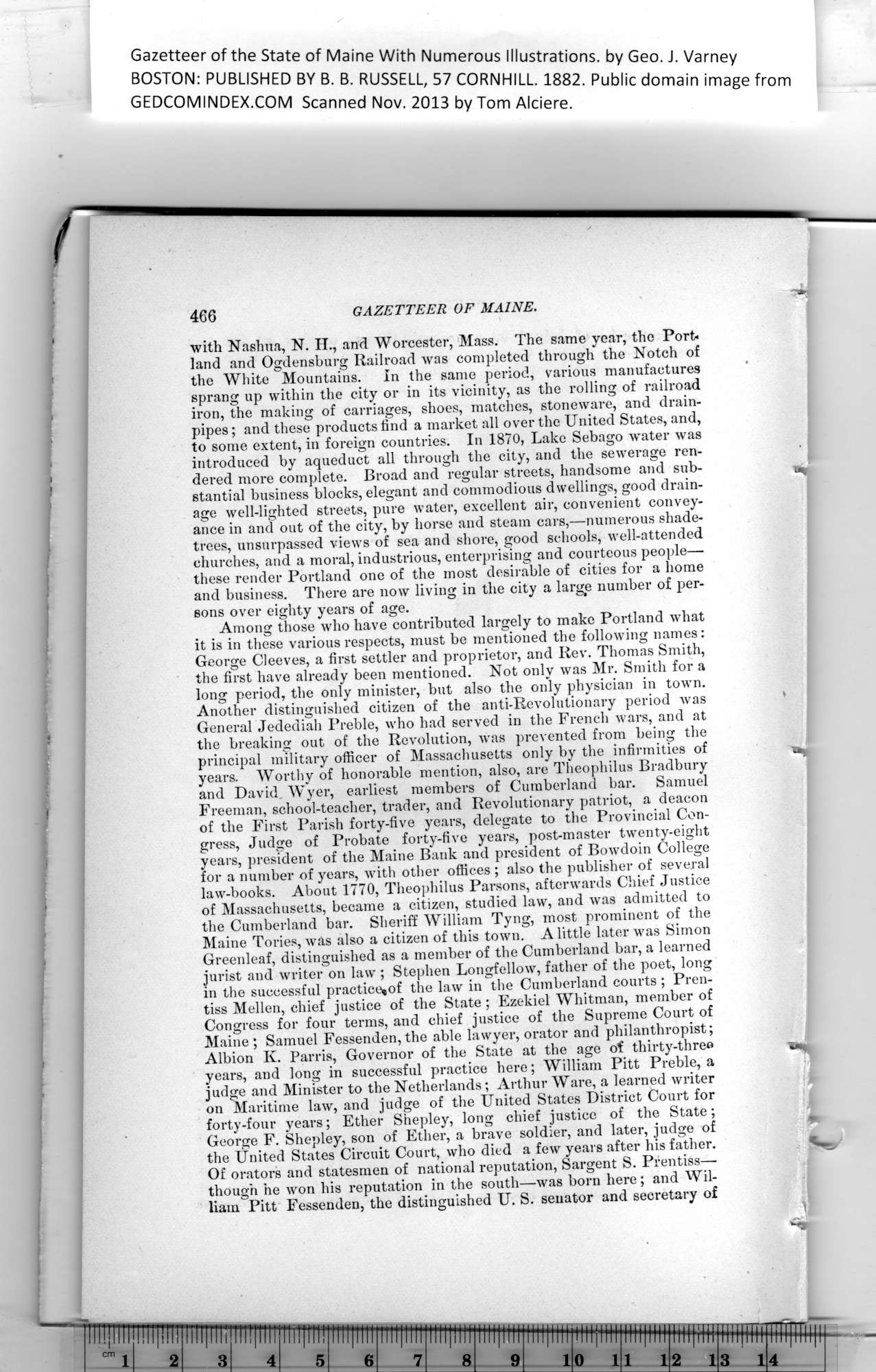|
Gazetteer of the State of Maine With Numerous illustrations, by Geo. J. Varney
BOSTON: PUBLISHED BY B. B. RUSSELL, 57 CORNHILL. 1882. Public domain image from
466 GAZETTEER OF MAINE.
with Nashua, N. H., and Worcester, Mass. The same year, the Port-
land and Ogdensburg Railroad was completed through the Notch of
the White Mountains. In the same period, various manufactures
sprang up within the city or in its vicinity, as the rolling of railroad
iron, the making of carriages, shoes, matches, stoneware, and drain-
pipes ; and these products find a market all over the United States, and,
to some extent, in foreign countries. In 1870, Lake Sebago water was
introduced by aqueduct all through the city, and the sewerage ren-
dered more complete. Broad and regular streets, handsome and sub-
stantial business blocks, elegant and commodious dwellings, good drain-
age well-lighted streets, pure water, excellent air, convenient convey-
ance in and out of the city, by horse and steam cars,—numerous shade-
trees, unsurpassed views of sea and shore, good schools, well-attended
churches, and a moral, industrious, enterprising and courteous people—
these render Portland one of the most desirable of cities for a home
and business. There are now living in the city a large number of per-
sons over eighty years of age.
Among those who have contributed largely to make Portland what
it is in these various respects, must be mentioned the following names:
George Cleeves, a first settler and proprietor, and Rev. Thomas Smith,
the first have already been mentioned. Not only was Mr. Smith for a
long period, the only minister, but also the only physician in town.
Another distinguished citizen of the anti-Revolutionary period was
General Jedediah Preble, who had served in the French wars, and at
the breaking out of the Revolution, was prevented from being the
principal military officer of Massachusetts only by the infirmities of
years. Worthy of honorable mention, also, are Theopliilus Bradbury
and David Wyer, earliest members of Cumberland bar. Samuel
Freeman, school-teacher, trader, and Revolutionary patriot, a deacon
of the First Parish forty-five years, delegate to the Provincial Con-
gress, Judge of Probate forty-five years, post-master twenty-eight
years, president of the Maine Bank and president of Bowdoin College
for a number of years, with other offices ; also the publisher of several
law-books. About 1770, Theophilus Parsons, afterwards Chief Justice
of Massachusetts, became a citizen, studied law, and was admitted to
the Cumberland bar. Sheriff William Tyng, most prominent of the
Maine Tories, was also a citizen of this town. A little later was Simon
Greenleaf, distinguished as a member of the Cumberland bar, a learned
jurist and writer on law; Stephen Longfellow, father of the poet, long
in the successful practice,of the law in the Cumberland courts ; Pren-
tiss Mellen, chief justice of the State; Ezekiel Whitman, member of
Congress for four terms, and chief justice of the Supreme Court of
Maine; Samuel Fessenden, the able lawyer, orator and philanthropist;
Albion K. Parris, Governor of the State at the age of thirty-three ^
years, and long in successful practice here; William Pitt Preble, a t
judge and Minister to the Netherlands; Arthur Ware, a learned writer »
on Maritime law, and judge of the United States District Court for 3
forty-four years; Ether Snepley, long chief justice of the State; J
George F. Shepley, son of Ether, a brave soldier, and later, judge of
the United States Circuit Court, who died a few years after his father.
Of orators and statesmen of national reputation, Sargent S. Prentiss—
though he won his reputation in the south—was born here; and Wil-
liam Pitt Fessenden, the distinguished U. S. senator and secretary of
PREVIOUS PAGE ... NEXT PAGE
This page was written in HTML using a program written in Python 3.2
|
